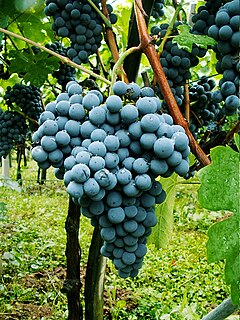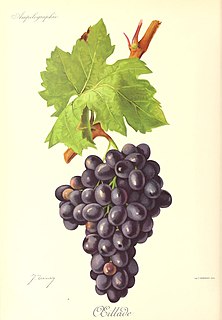
Carignan is a red grape variety of Spanish origin that is more commonly found in French wine but is widely planted throughout the western Mediterranean and around the globe. Along with Aramon, it was considered one of the main grapes responsible for France's wine lake and was a substantial producer in jug wine production in California's Central Valley but in recent years, it has been reborn as a flagship wine for many cellars in the south of France as well as in Catalonia.

Old vine, a common description on wine labels, indicates that a wine is the product of grape vines that are notably old. There is a general belief that older vines, when properly handled, will give a better wine. There is no legal or generally agreed definition for old.

Tisens is a comune (municipality) in South Tyrol in northern Italy, located about 15 kilometres (9 mi) northwest of the city of Bolzano.

Mondeuse noire is a red French wine grape variety that is grown primarily in the Savoy region of eastern France. The grape can also be found in Argentina, Australia, California, Switzerland and Sicily. Plantings of Mondeuse noire was hit hard during the phylloxera epidemic of the mid to late 19th century which nearly wiped out the vine from eastern France. While the grape recovered slightly in the 20th century, French plantations of Mondeuse noire fell sharply in the 1970s, with just over 200 hectares left in France in 2000. In the early 21st century, it seems the variety has increased somewhat in popularity, as it can give good wines if the planting site is chosen carefully.
Bouchalès or Grapput is a red French wine grape variety that is grown primarily in Bordeaux and Southwest France wine appellations. Plantings have declined in recent years as the vine has shown high sensitivity to downy mildew and black rot.
Uva Tosca is a red Italian wine grape variety that is grown in the Emilia-Romagna region of east-central Italy where it is the only grape variety able to grow in the higher elevations of the Val Secchia area. Despite what its name may allude to, ampelographers have little evidence to believe that the grape originated in Tuscany or has any close genetic relationship with the notable Tuscan wine grape, Sangiovese, that is also known under the synonym of Uva Tosca. In 2010, DNA analysis suggested that Uva Tosca may be a natural crossing between the Alto-Adige wine grape Schiava Grossa and Crepallocchi.

Žametovka is a red Slovenian wine grape variety. This is one of the oldest domesticated grape varieties in Slovenian. Formerly it was popular in Styrian vineyards, and even more so, even today, known in Dolenjska in southeast Slovenia - from the reddish wine cviček. It produces a wine of pure red color. A single vine of Žametovka growing in the Slovenian town of Maribor is estimated by the Guinness Book of Records to be the oldest living vine still producing fruit in the world at over 400 years of age.
Camaraou noir is a red French wine grape variety that was historically grown in South West France but is now more widely planted in the Spanish wine region of Galicia where it is known as Espadeiro. However, despite its Spanish synonym Camaraou noir has no relationship to the Portuguese wine grape Espadeiro that is used to make red Vinho Verde. The grape may have some relation to the Jurançon and Béarn wine grape Camaralet de Lasseube which is also known as Camaraou blanc but DNA analysis has shown that the two varieties are distinct and not color mutations of one or the other.

Œillade noire is a red French wine grape variety that has been historically grown in the Languedoc and Provence wine region but it is now close to extinction. The grape is often confused for the Rhone wine grape Cinsault which is known under the synonym œillade noire when it is sold as a table grape. It was also once thought to be a color mutation of Picardan which is known as œillade blanche and share several similar synonyms to œillade noire. However the grape has no known relation to both Cinsault and Picardan.
Gueuche noir is a red French wine grape variety that has been historically grown in the Franche-Comté of eastern France but is now close to being extinct. Though its exact relationship has not yet been determined by DNA analysis, ampelographers believe that the grape variety is closely related to the Hunnic grape Gouais blanc which is notable for being the mother vine to several grape varieties including Chardonnay and Gamay. There also might be a relationship between Gueuche noir and the Jura wine grape Enfariné noir.
Catanese nero is a red Italian wine grape variety that is predominantly grown in Sicily. While ampelographers believe that grape likely originated in the shadow of Mount Etna in province of Catania on the east coast of the island, today it is mostly grown in the northwestern provinces of Agrigento, Palermo and Trapani. A minor blending variety used in rosé production, the grape is not currently permitted for use in any Denominazione di origine controllata classified wines.

Vermentino nero is a red Italian wine grape variety that is predominantly grown in province of Massa-Carrara in Tuscany. After World War II, the vine was almost lost to extinction until Podere Scurtarola, a producer from Massa, began replanting old vineyards with the grape. By 2000, there were 199 hectares of Vermentino nero growing in Italy with the grape authorized for production in the Denominazione di origine controllata (DOC) wines of Candia dei Colli Apuani and Colline Lucchesi.
Cascarolo bianco is a white Italian wine grape variety that is grown primarily in the Piedmont wine region of northwest Italy. The grape has a long history in the region and was noted in 1606 by Giovanni Battista Croce, vineyard owner and official jeweler to Charles Emmanuel I, Duke of Savoy, as growing in the hills around Torino and producing wine of high esteem. It was once thought that Cascarolo bianco was the same variety as the Hungarian wine grape Fehér Gohér but DNA profiling in the early 21st century determined that the two grapes are unrelated. Today ampelographers believe that the grape is an offspring of the Swiss wine grape Rèze with DNA evidence suggesting some relationship with another white Piedmontese grape, Erbaluce.
Lagarino bianco is a white Italian wine grape variety that is grown in the Trentino-Alto Adige/Südtirol wine region of northeast Italy. It was once thought that the grape was a white berry color mutation or offspring of South Tyrolean grape Lagrein with a weiss Lagrien grape variety reportedly growing near the commune of Bolzano in 1318 but DNA profiling conducted in the early 21st century has shown that the two grape varieties are distinct with no direct relationship to each other.
Bariadorgia is a white Italian/French wine grape variety that likely originated on the island of Sardinia but today is only found in limited planting on Corsica. Despite similarities in synonyms, Bariadorgia/Carcajolo blanc is not a color mutation of the red Spanish wine grape Parraleta which is also known as Carcajolo near on Sardinia.

Prié blanc is a white Italian wine grape variety that is grown almost exclusively in the Valle d'Aosta DOC of northwest Italy. The Valle d'Aosta varietal wine Blanc de Morgex et de La Salle is made from Prié blanc grapes.
Vuillermin is a red Italian wine grape variety grown along the border of Switzerland in the Aosta Valley of northwest Italy. First documented under the name Vuillermin in 1890, the grape was virtually extinct until it was discovered by ampelographers at the Institut Agricole Régional of Aosta growing in isolated vineyards in communes of Châtillon and Pontey.
Uvalino is a red Italian wine grape variety that is grown in the Piedmont wine region of northwest Italy. While the name uvalino means "small berries", ampelographers believe that the name may be derived from uvario which in the local Piedmontese dialect was used to denote wine grapes that were primarily minor blending varieties.
Barsaglina is a red Italian wine grape variety that is grown in Tuscany and Liguria where it most often used to add color and tannins to blends. Some ampelographers speculate that grape may be related to Sangiovese due to morphological similarities. Barsaglina was near extinction until a Tuscan wine producer, Paolo Storchi, help revive the variety by making it a significant component of his red Indicazione Geografica Tipica (IGT) Toscana blend. The grape is also permitted to be used in the Denominazione di Origine Controllata (DOC) wines of Colli di Luni.
Bigolona is a white Italian wine grape variety from the Valpolicella region of northeast Italy where it has been growing since at least the early 19th century. The wine has traditionally been used in the production of late harvest and botrytized dessert wines with the grape's synonym Smarzirola being derived from the Italian marcire meaning "to rot".











